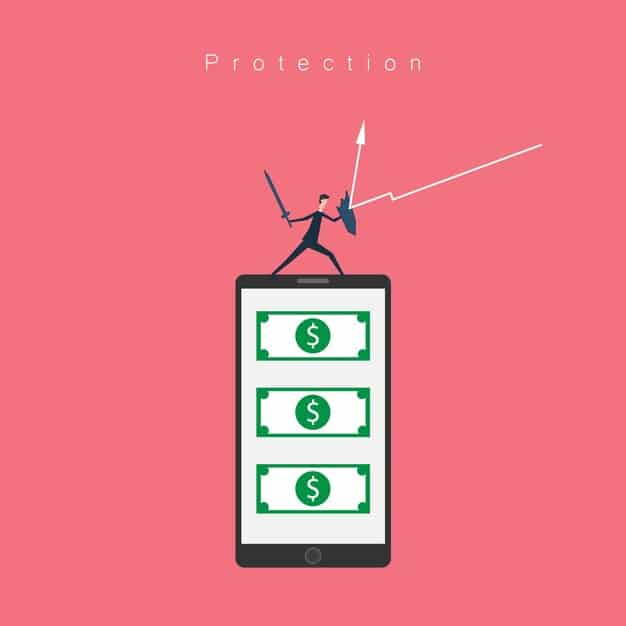Mobile Payment Security: Reduce E-commerce Fraud by 15%

Securing mobile payments in US e-commerce apps involves implementing robust authentication, real-time fraud monitoring, and secure data encryption to minimize fraud by up to 15%.
Is your US e-commerce app vulnerable to mobile payment fraud? Safeguarding your customers’ financial data while ensuring a smooth transaction process is paramount. Discover how to enhance mobile payment security: 3 steps to reduce fraud by 15% in your US e-commerce app.
Understanding the Landscape of Mobile Payment Fraud in the US
Mobile payment fraud is a growing concern for e-commerce businesses in the United States, with sophisticated schemes targeting vulnerabilities in mobile applications. Understanding the types of threats and their impact is the first step towards implementing effective security measures. Let’s delve into the current state of mobile payment fraud.
Common Types of Mobile Payment Fraud
Fraudsters employ various techniques to exploit mobile payment systems, including:
- Phishing Attacks: Deceptive emails or messages designed to trick users into revealing their payment credentials.
- Malware Infections: Malicious software that steals payment information stored on mobile devices.
- Account Takeovers: Gaining unauthorized access to user accounts to make fraudulent purchases.
- Carding Attacks: Using stolen credit card numbers to make purchases through mobile apps.
These attacks can result in significant financial losses for both businesses and consumers, damaging trust and brand reputation.
The Economic Impact of Fraud
The rise in mobile payment fraud has a substantial economic impact on the US e-commerce market. Businesses incur direct financial losses from fraudulent transactions, as well as indirect costs related to fraud prevention, investigation, and customer compensation.

Furthermore, the perception of insecurity can deter customers from using mobile payment methods, impacting overall sales and growth. Investing in mobile payment security is not just a matter of preventing losses, but also fostering trust and confidence in the mobile commerce ecosystem.
In conclusion, understanding the current landscape of mobile payment fraud, including the common types of threats and their economic impact, is essential for developing effective security strategies and protecting your business and customers in the US e-commerce market.
Step 1: Implement Robust Multi-Factor Authentication (MFA)
Multi-factor authentication (MFA) adds an extra layer of security by requiring users to provide multiple verification factors before accessing their accounts or making transactions. Implementing robust MFA can significantly reduce the risk of unauthorized access and mobile payment security breaches.
Understanding Multi-Factor Authentication
MFA combines two or more independent credentials to verify a user’s identity. Common authentication factors include:
- Something You Know: Password or PIN
- Something You Have: One-time code sent to mobile device via SMS or authenticator app
- Something You Are: Biometric authentication such as fingerprint or facial recognition
By requiring multiple factors, MFA makes it much harder for fraudsters to gain access to accounts, even if they manage to obtain one of the credentials.
How to Implement MFA in Your App
Implementing MFA in your app involves several key steps:
- Choose Appropriate Factors: Select authentication factors that are suitable for your target users, considering usability and security tradeoffs.
- Integrate with Authentication Systems: Integrate MFA into your existing authentication systems, ensuring compatibility and seamless user experience.
- Provide User Education: Educate users about the importance of MFA and how to use it effectively.
- Monitor and Update: Continuously monitor the performance of your MFA implementation and update it as needed to address emerging threats.
Properly implemented MFA can dramatically increase the security of your app and protect your users from mobile payment security fraud.
Step 2: Real-Time Fraud Monitoring and Detection
Real-time fraud monitoring and detection systems analyze transaction data in real-time to identify and flag suspicious activities. By detecting and responding to fraudulent transactions promptly, you can minimize losses and protect your customers. Let’s explore how to implement such systems.
The Importance of Real-Time Monitoring
Real-time monitoring allows you to:
- Identify Suspicious Transactions: Analyze transaction data in real-time to identify transactions that deviate from normal user behavior.
- Flag High-Risk Activities: Automatically flag transactions that meet predefined risk criteria, such as unusual transaction amounts or locations.
- Respond Promptly to Fraud: Take immediate action to prevent fraudulent transactions, such as blocking suspicious accounts or requiring additional verification steps.
- Adapt to Evolving Threats: Continuously update your fraud detection rules to stay ahead of emerging fraud techniques.
Real-time monitoring is a critical component of a comprehensive mobile payment security strategy.
Techniques for Fraud Detection
Several techniques can be used for real-time fraud detection, including:
- Rule-Based Systems: Define rules based on known fraud patterns and risk indicators to automatically flag suspicious transactions.
- Machine Learning Algorithms: Use machine learning algorithms to analyze transaction data and identify anomalies that may indicate fraud.
- Behavioral Biometrics: Analyze user behavior patterns such as typing speed, mouse movements, and touch gestures to detect unusual activities.
These techniques can be used independently or in combination to create a robust fraud detection system.

In conclusion, implementing real-time fraud monitoring and detection systems is essential for protecting your e-commerce app from mobile payment security fraud and minimizing financial losses.
Step 3: Secure Data Encryption and Tokenization
Secure data encryption and tokenization are essential for protecting sensitive payment information during transmission and storage. By encrypting data and replacing sensitive information with tokens, you can reduce the risk of data breaches and minimize the impact of fraud. Let’s examine the advantages of these security measures.
Understanding Encryption and Tokenization
Encryption and tokenization are techniques used to protect sensitive data:
- Encryption: Converts data into an unreadable format using cryptographic algorithms, preventing unauthorized access.
- Tokenization: Replaces sensitive data with non-sensitive tokens, which can be used for payment processing without exposing the actual data.
These techniques help to safeguard payment information and comply with data security standards and regulations.
Implementing Secure Data Handling
Implementing secure data handling involves:
- Encrypting Data in Transit: Use secure protocols such as HTTPS to encrypt data during transmission between your app and payment processors.
- Encrypting Data at Rest: Encrypt sensitive data stored on your servers or mobile devices to prevent unauthorized access.
- Tokenizing Payment Information: Replace credit card numbers and other payment data with tokens, minimizing the risk of data breaches.
- Complying with PCI DSS: Follow the Payment Card Industry Data Security Standard (PCI DSS) to ensure secure handling of payment information.
By implementing these measures, you can protect your customers’ payment information and reduce the risk of mobile payment security fraud.
The Role of User Education in Mobile Payment Security
User education is a crucial aspect of mobile payment security. Educating users about safe payment practices can help prevent fraud and protect their financial information. Let’s explore the significance of user awareness and how to promote it effectively.
Why User Education Matters
Educating users can help them:
- Recognize Phishing Attempts: Teach users how to identify and avoid phishing emails and messages that try to steal their payment credentials.
- Protect Account Credentials: Encourage users to create strong, unique passwords and protect their accounts with MFA.
- Report Suspicious Activities: Encourage users to report any suspicious transactions or account activities to your customer support team.
Informed users are less likely to fall victim to fraud and can act as a frontline defense against cyberattacks.
Creating a culture of security awareness can significantly reduce the risk of fraud and protect your customers’ financial information.
Tips for User Education
Some effective tips to make a better mobile payment security are:
- Provide Clear and Concise Information: Use simple language and clear visuals to explain important security concepts.
- Use a Good Password: Educate users on why they should use complex and different passwords for different accounts.
- Leverage Multiple Channels: Use various channels such as in-app messages, email newsletters, and social media to reach users with security tips.
Continuously reinforcing security best practices can create a more secure mobile payment environment for your users.
Measuring the Effectiveness of Your Security Measures
Measuring the effectiveness of your mobile payment security measures is crucial for identifying areas for improvement and demonstrating the value of your security investments. By tracking key metrics and analyzing fraud trends, you can optimize your security strategies and reduce fraud losses. Let’s explore how to assess the efficacy of your security measures.
Key Metrics to Track
Track metrics such as:
- Fraud Rate: The percentage of transactions that are fraudulent.
- Chargeback Rate: The percentage of transactions that result in chargebacks due to fraud.
- Fraud Detection Rate: The percentage of fraudulent transactions that are successfully detected by your fraud detection systems.
Analyzing these metrics can provide valuable insights into the performance of your security measures.
Analyzing Fraud Trends
Analyze fraud trends to identify emerging fraud techniques and patterns. This analysis can help you to:
- Understand Fraudster Tactics: Identify the methods that fraudsters are using to exploit your system.
- Adapt Your Security Measures: Update your fraud detection rules and security measures to address emerging threats.
- Prioritize Security Investments: Allocate resources to the areas that are most vulnerable to fraud.
Conclusion: Measuring the effectiveness of your security measures is essential for optimizing your fraud prevention strategies and protecting your business and customers from mobile payment security fraud.
| Key Point | Brief Description |
|---|---|
| 🔐 MFA Implementation | Enhance security with multi-factor authentication, combining passwords, one-time codes, and biometrics. |
| 🚨 Real-Time Monitoring | Detect and respond to fraudulent transactions promptly by analyzing data in real-time. |
| 🛡️ Data Encryption | Protect sensitive payment information using secure data encryption and tokenization techniques. |
| 🧑🏫 User Education | Educate users to recognize phishing and use safe online payment ways. |
FAQ
▼
MFA is a security system that requires more than one method of authentication from independent categories of credentials to verify the user’s identity for a login or other transaction.
▼
Real-time fraud monitoring analyzes transactions as they occur, using rules and algorithms to identify suspicious activity and flag potentially fraudulent transactions for review.
▼
Data encryption transforms data into an unreadable format to protect it from unauthorized access, ensuring sensitive information remains confidential during transmission and storage.
▼
User education teaches consumers to recognize phishing attempts, protect their account credentials, and report suspicious activities, helping them avoid becoming victims of fraud.
▼
Key metrics include fraud rate, chargeback rate, and fraud detection rate. Tracking these metrics helps assess the performance of security measures and identify areas for improvement.
Conclusion
Enhancing mobile payment security in your US e-commerce app requires a multi-faceted approach encompassing robust authentication, real-time monitoring, and secure data handling. By implementing these steps and continuously adapting to emerging threats, you can reduce fraud, protect your customers, and build a more secure mobile commerce environment.





